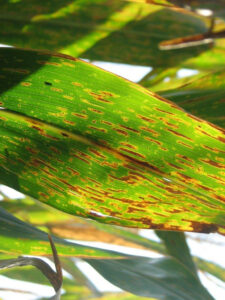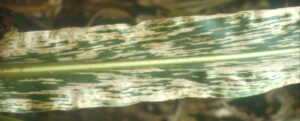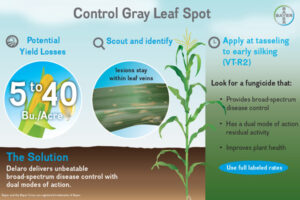Introduction
Gray leaf spot (GLS) is caused by the fungus Cercospora zeae-maydis. GLS can occur in corn almost every growing season. If conditions favor disease development, gray leaf spot can cause economic losses across the North Central and Southeast corn-producing regions. Gray leaf spot is one of corn’s most frequent and aggressive diseases, and its economic impact has increased in many regions of the world over the past 10 years.1 This disease causes crop losses by reducing the plant’s photosynthetic surface area, resulting in a loss of photosynthetic activity that can cause a loss of yield potential and grain quality (kernel size and test weight). Planting corn products with a low level of gray leaf spot susceptibility can reduce the amount of potential yield loss.
Symptoms
Gray leaf spot lesions start out as small, light tan to brown lesions with yellow margins, which first appear on the lower leaves two to three weeks before tasseling. An in-field diagnostic technique for identifying GLS is to hold the leaf up to light and look for a faint, watery halo surrounding the lesion. The lesion shapes are usually rectangular during the early infection, as the shape is limited by leaf veins which are 1/16 to 1/8 inch wide. Within two to three weeks, these lesions begin to elongate. In about two weeks the lesions begin to turn gray and reach a length up to three to four inches but will often maintain the rectangular shape (Figure 2). Later in the season, these lesions can join and kill entire leaves. GLS can be confused with other foliar diseases such as anthracnose leaf blight, eyespot, or common rust.

Figure 1. Gray leaf spot on corn that is backlit to show a faint, watery halo around lesions.

Figure 2. Gray leaf spot infection on corn.

Figure 3. Severe infection of gray leaf spot on corn. Hot and dry conditions restrict the growth of the lesions and give them a yellowish color, without defined borders. As the lesions expand, large areas of leaf tissue can be destroyed (Figure 3). The light-brown color changes to a silver-grey color as warm and humid environmental conditions allow the fungus to produce fungal conidia (spore-forming structures

Figure 4. Gray leaf spot in corn infographic.
Disease Cycle
Gray leaf spot overwinters in and on corn debris left above and on the soil surface. As temperature and humidity increases, spores are produced on the debris (Figure 4). Wind or water can blow or splash the spores onto the lower leaves of the growing corn crop. Infection usually occurs in June, but rapid spread of the disease usually begins in late July and August, when warm and humid conditions are more common. As with most foliar diseases, the earlier the infection occurs, the more time there is for secondary spread in the field which leads to an increased probability of economic yield loss.
Environmental conditions that allow expansion of gray leaf spot are temperatures between 77 and 86 °F, high humidity (>90% for 12+ hours), and moisture. In addition to conducive environmental conditions, the susceptibility level of the corn product will also dictate lesion expansion. Hot and dry conditions can stall the development of the disease, but development will continue once favorable disease conditions return. The greatest risk of gray leaf spot infection occurs in susceptible corn products that are planted in areas where dew forms on the plant, which keeps the leaf surface moist for extended periods of time.
Disease Impact
Yield can be significantly reduced when conditions are conducive to the disease and if a corn product is susceptible to gray leaf spot. While estimates are not available for all hybrid types and conditions, general estimates are available from Ohio State University (Table 1).
As with most foliar diseases, the reduction in photosynthetic capacity caused by gray leaf spot also increases the likelihood of late-season stalk lodging and infection by stalk rot diseases, in addition to the possible yield loss the disease may cause.

Management
Use of preventative management tactics—such as using a corn product that is less susceptible to gray leaf spot, practicing crop rotation, removing corn residue, or using tillage to promote the decomposition of corn debris—can help reduce the impact of gray leaf spot in high-risk fields. Gray leaf spot fungi overwinter in corn residue and can build up in corn-on-corn rotations or in reduced till/no-till cropping systems. A rotation of at least two years is recommended for fields utilizing conservation tillage and may be necessary to reduce inoculum levels, as the spores can survive for longer than a year on corn residue. Consult with your seed professional on corn products that have a low level of susceptibility and provide any other needed agronomic benefits
In fields where there is concern about GLS, scouting should start around V-10 to V-14 (10th to 14th leaf collar is visible), which should give an idea of the severity of the field infection. If gray leaf spot is present and weather conditions remain favorable for the disease, an in-season fungicide application can provide protection against grain yield loss. In most cases, fungicides should be applied at or after tasseling through the early silk growth stage (VT to R1 growth stage). Fungicide products containing a strobilurin and strobilurin/triazole premix are most effective at preventing yield loss when applied in response to GLS disease presence. Delaro® 325 SC fungicide is a dual mode of action fungicide labeled for gray leaf spot and can be sprayed at this critical time where necessary. To learn more about Delaro® ungicide, please visit https://www.cropscience.bayer. us/products/fungicides/delaro/resources/gray-leaf-spot and contact your retailer. Follow all individual product label instructions for proper application timing, application volume, application equipment, and environmental and harvest interval precautions.

Figure 5. Gray leaf spot control with Delaro®1
